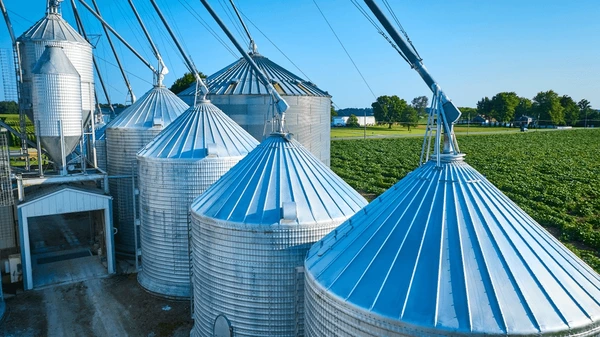The agricultural sector is witnessing a technological revolution, with the integration of smart technologies transforming traditional farming practices. One such groundbreaking development is the use of the Internet of Things (IoT) in grain silos.
By incorporating IoT, farmers are not only improving grain storage efficiency but also significantly reducing waste, enhancing monitoring capabilities, and ultimately boosting profitability.
Let’s explore how IoT is revolutionizing grain silo management, enabling farmers to make more informed decisions for better crop outcomes.
Understanding IoT in Grain Silos
The Internet of Things (IoT) is a network of physical devices that communicate with each other via the internet, enabling data collection, analysis, and control.
In the context of grain silos, IoT refers to the deployment of sensors and connected devices that monitor environmental conditions inside the silos, such as temperature, humidity, and grain levels.
This data is collected in real-time and relayed to farmers through mobile devices or cloud-based platforms, allowing for precision grain management.
Traditionally, grain silos required manual inspection to ensure optimal storage conditions, which could be time-consuming and prone to errors. However, with IoT in grain silos, farmers can maintain full visibility over their stored grain and respond proactively to prevent spoilage.
This shift from manual processes to automated monitoring offers a new era of efficiency and sustainability in agriculture.
The Benefits of IoT-Enabled Grain Silos
- Real-Time Monitoring and Alerts
One of the key benefits of using IoT in grain silos is the ability to monitor conditions in real-time. Sensors inside the silo continuously collect data on temperature, humidity, and other environmental factors that influence grain quality.
The IoT system sends alerts whenever conditions deviate from the desired range, enabling farmers to take immediate corrective action. For example, if humidity levels rise above the threshold, it could lead to mold growth, compromising the quality of the grain. With real-time notifications, farmers can initiate ventilation or other corrective measures to prevent losses.
- Preventing Post-Harvest Losses
Post-harvest losses due to improper storage are a significant concern for farmers worldwide. IoT in grain silos helps mitigate this issue by providing precise control over storage conditions.
By maintaining optimal temperature and humidity levels, IoT sensors prevent spoilage, insect infestations, and fungal growth. Additionally, the integration of IoT with predictive analytics can help forecast potential issues based on historical data, allowing farmers to take preventive measures before problems arise. The result is minimized waste and maximum yield preservation, contributing to both farm profitability and food security.
- Remote Control and Automation
IoT technology allows farmers to remotely monitor and control their grain silos from anywhere in the world using a smartphone or tablet. This remote access is especially beneficial for large-scale farms with multiple silos spread across different locations.
Automation features, such as auto-regulation of ventilation systems based on sensor data, further enhance the efficiency of grain management. Farmers no longer need to be physically present to adjust storage conditions, saving time and labor while ensuring optimal grain quality.
- Enhanced Decision-Making through Data Analytics
IoT in grain silos generates large volumes of data, which can be analyzed to gain insights into storage conditions and grain health. Advanced analytics tools can identify trends, predict potential problems, and suggest corrective actions.
- Advertisement -By leveraging these insights, farmers can make informed decisions to enhance storage efficiency. For instance, data analysis can reveal patterns such as increased temperature in specific parts of the silo, indicating the need for improved aeration or pest control. The ability to use data to make proactive decisions helps farmers optimize grain storage and reduce losses.
- Integration with the Broader Farm Management System
IoT in grain silos can be integrated with broader farm management systems to create a holistic approach to agricultural operations. By connecting silo sensors with other IoT devices on the farm—such as soil moisture sensors, weather stations, and irrigation systems—farmers can gain a comprehensive view of the entire farm.
This interconnected system enables farmers to plan better and make strategic decisions that benefit overall productivity. For example, understanding grain storage levels can help farmers decide the best time to harvest or purchase additional storage capacity, leading to more efficient resource use and improved profitability.
Challenges and Considerations
While IoT in grain silos presents numerous benefits, there are challenges that must be considered. The initial investment in IoT infrastructure can be a significant barrier for small-scale farmers.
Additionally, reliable internet connectivity is crucial for the proper functioning of IoT systems, which can be a challenge in rural areas. However, as technology continues to evolve and become more affordable, these barriers are expected to diminish, making IoT more accessible to a wider range of farmers.
The Future of IoT in Grain Silos
The application of IoT in grain silos represents just the beginning of what smart farming technologies can achieve. As artificial intelligence (AI) and machine learning (ML) are increasingly integrated with IoT systems, farmers will benefit from even greater automation and predictive capabilities.
This convergence of technologies will not only enhance the efficiency of grain storage but also contribute to sustainable agricultural practices by reducing waste and optimizing resource use.
Conclusion
Leveraging IoT in grain silos marks a significant leap forward in precision grain management, offering real-time monitoring, automation, and data-driven decision-making.
By adopting IoT technology, farmers can minimize post-harvest losses, enhance grain quality, and streamline their operations.
As the agricultural sector continues to embrace digital transformation, IoT in grain silos will play a pivotal role in ensuring efficient, profitable, and sustainable farming practices.
For farmers looking to improve their storage systems, IoT offers an opportunity to harness cutting-edge technology for better productivity, reduced waste, and increased profitability—ultimately contributing to the broader goal of global food security.
Also Read
How GPS-enabled tractors are changing the face of farming
Zimbabwe’s Champions Insurance boosts farmers with satellite imagery technology
